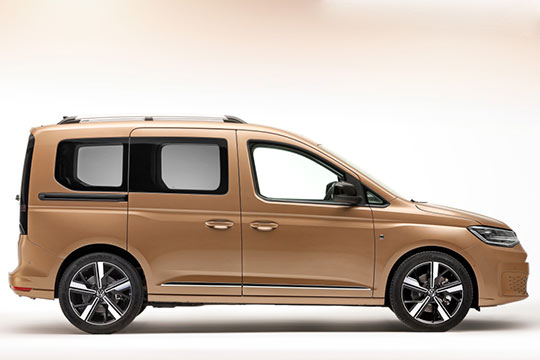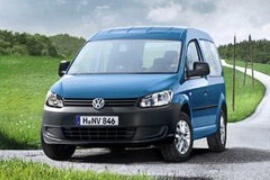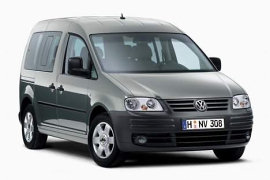VOLKSWAGEN Caddy Models/Series Timeline, Specifications & Photos
First production year: 2005
Engines: Diesel, Gasoline, Natural gas
Body style: Van
The fifth generation of the small VW carrier was shown in 2020 and the news about it are rather interesting. It is the first VW commercial vehicle that uses the MQB platform. The first Caddy was based on the VW Golf Mk1 and it was named the Rabbit Pickup in North America. The second generation was based on the VW Polo and the third on a small Czech utility vehicle, the Skoda Favorit. The fourth generation had its own mix of components, from Polo and Golf plus some other parts specially engineered for it.
The 2020 generation received more passenger-type characteristics, in order to be more like a family-car for a small entrepreneur, contractor or handyman. In its longest variant, the Caddy can be loaded with two Euro pallets of cargo, sideways or via the rear doors.
Power comes from a turbodiesel in two power outputs (75hp and 122hp), a turbo-gasoline (TSI) unit with 116 hp and a turbocharged natural-gas engine (TGI). These options are made to meet the strictest 2021 emission standards. For instance, the TDI versions have a double SCR (emission control system) to lower the NOX figures.
The interior for the 2020 Caddy is enhanced, being more like a car and less like a van. It even has an infotainment unit with a touchscreen of up to 10” in size.
The Caddy evolved from a version of the Polo to a distinct range built by Volkswagen Commercial Vehicles, not by the Volkswagen car division.
The carmaker built the passenger version of the Caddy in two versions, with a short or long wheelbase. Volkswagen revised both of them in 2010. Apart from their looks, the vehicle received new engines and transmissions, including an all-wheel-drive system for the Maxi Life, which was available only for the regular wheelbase Caddy before the facelift.
At the front, the 2010 Caddy featured similar headlights as the Golf 6 and the Touran's second generation. Regardless of the trim level, all versions got a black grille. Its bumper was black for the base levels and body-colored, starting with the second trim level. The carmaker installed sliding doors for the rear seat passengers, while at the back, it offered a choice of side-hinged doors or a wide liftgate.
Inside, the carmaker couldn't hide the vehicle's utilitarian roots. Its plastic dashboard and the storage areas on top of it on the passenger side provided some extra space, but they didn't look designed for a family van. Its instrument cluster was similar to the one installed in the Touran. In the back, there was plenty of room for three adult passengers. In the Maxi Life version, the Caddy provided two additional jump seats in the trunk area.
Under the hood, Volkswagen dropped the formerly used 1.4-liter gasoline engine and installed the 1.2-liter units, following the downsizing trend in the automotive industry. Also, it retired the 1.9-liter diesel engine due to the Dieselgate scandal and replaced it with a much modern 1.6-liter TDI. The 2.0-liter TDI lost the most powerful, 140 hp version from the non-facelifted version.
Volkswagen released the third Caddy generation in 2003, and in 2005, it received a mildly facelifted version for the entire range, including the passenger version named Caddy Life.
Available in two lengths, the Caddy was developed on a hybrid platform. It shared many of its underpinnings with the Volkswagen Golf MKV and the Touran but with a different rear suspension fit for a light utility vehicle.
With a front fascia that resembled the Touran and a raked windshield continued by the metallic roof, the Caddy looked halfway between a utility vehicle and a minivan. It wasn't a doll on the base trim levels with its black, unpainted plastic bumper. Yet, it sported body-colored bumpers and fog lights in the upper trim levels, which made the vehicle look more like an MPV than an LCV. For the Caddy Life, the carmaker included a standard rear sliding door on the driver's side, with an option for a second one on the passenger's side. At the back, the carmaker offered a choice for either a liftgate or two unequal, side-hinged doors (fridge doors).
Inside, the connection with a utility vehicle was evident in the dashboard's design. There were plenty of storage areas on the dashboard. Above the windshield, under the ceiling, the carmaker added another storage shelf. All of these were good, but the plastic quality was also from the same LCV segment. In the back, the regular-sized Caddy offered a bench for three passengers while the Caddy Maxi provided room for two extra seats in the trunk area.
Under the hood, the carmaker offered more turbo-diesel versions than gasoline engines and paired them as standard with a five-speed manual gearbox. Later on, it added an automatic gearbox for specific powerplants and an all-wheel-drive version.


